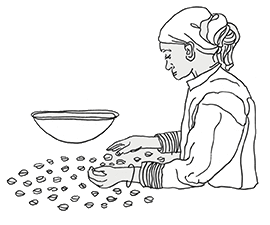About Bombe Natural
Ethiopia’s Sidamo region is one of the best-known coffee-growing areas in the world. Like the rest of Ethiopia, it’s divided into several woredas (districts) and kebeles (communities) with washing stations throughout—each offering unique terroir. The Bensa woreda is one of them, and within it lies the Bombe kebele.
To get to Bensa we have to fly to the capital of Ethiopia, Addis Ababa, then take a local flight to Hawassa. The next leg of the journey to Bensa is 3 hours via car. There, we find the central washing station.
Bensa lies within a valley in a very mountainous area of Sidamo with kebeles throughout. This mountain chain can reach 3,000 meters above sea level. There are access roads to get to the farms. Travel time for producers throughout Bensa is often the same walking (typically transporting coffee via mule) or going by truck: approximately 1 hour.
Bombe producers’ main income source is coffee, which they grow on very small farms ranging from 0.1 to 2 hectares. They usually intercrop with false banana trees for shade. Fertilization rarely happens in this area.
In the Bensa washing station, the coffee is sundried in cherry on raised beds for 15 to 21 days, with frequent turning for even drying. Our partnerships here are notorious for meticulous natural processing (drying the coffee in cherry and then removing the cherry, as opposed to washing the fruit off then drying the coffee in parchment). The natural process is difficult to execute well: beans need to be turned frequently for consistent and even drying. It’s easy to end up with mold issues or an excess of fermentation flavor, or at the very least achieve an acceptable cup but overpower the natural terroir of the coffee (the unique flavor that comes from variety, soil, proper harvest, and clean processing). But, when done right, the results can be sublime, with the natural terroir of the coffee further enhanced by an additional injection of sweetness and high-impact fruit flavor.
The people of Bombe belong to the Sidamo culture and speak various dialects of the Sidamo language. They maintain ancient traditions, like their round housing structures which are identical to those used in this area 10,000 years ago, or family campfire gatherings at the end of each day. Bombe producers are near the forest and have retained many of the original indigenous coffee varieties, which bring the heat with small beans and intense, diverse flavor.
Until a few years ago, the people of Bombe used to grow only coffee and subsistence crops, but due to low or unreliable coffee prices and the high care needs that come with them, many in the area began to replace coffee with eucalyptus and khat (a commonly used stimulant in Africa). Unfortunately, these crops are harmful to the environment due to their large consumption of water, which depletes the water table. Coffee, on the other hand, is native to the forests of Ethiopia and can have a forest-protective effect.
Much of the traditional coffee-specific knowledge is being lost as coffee cultivation becomes marginalized for khat and eucalyptus. These newer, non-native crops grow independently and don’t need the same kind of agricultural management coffee requires, despite their disruption of the native environment. That ease is attractive and profitable for the young people of the area, who often end up replacing all the coffee on their farms if they aren’t selling their farms entirely.
There are still producers in Bombe who value coffee and want to preserve their ancient agricultural knowledge for generations to come. Those in the area who want to persevere in coffee find enthusiastic buyers for their elite product at Red Fox. This market access is crucial for the survival of coffee in Bensa and probably one of the few factors that limits the destructive production of khat and eucalyptus in the area.

